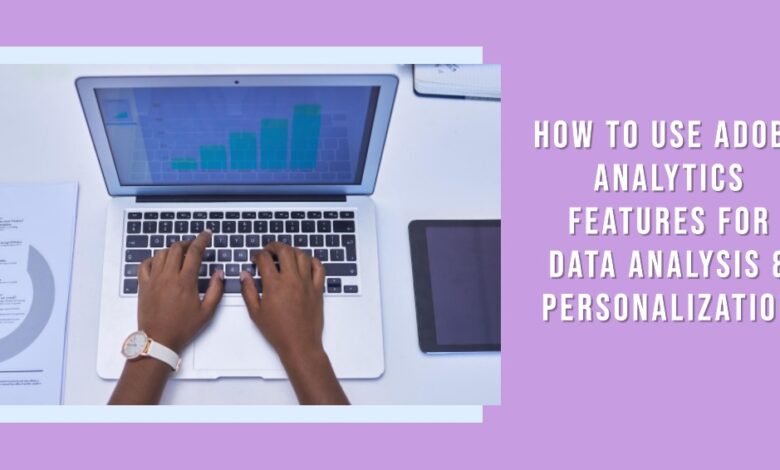
With Adobe Analytics features, businesses can conduct thorough data analysis, uncovering valuable insights that enable effective personalization strategies for delivering tailored and engaging experiences to their audience.
Organizations gather a lot of data to understand customers, improve products, and enhance experiences. But analyzing this data for useful insights can be a challenge. That’s where Adobe Analytics comes in.
Adobe Analytics, part of Adobe Experience Cloud, helps businesses make sense of data from various digital channels. It provides real-time insights, enabling effective marketing campaigns and better customer experiences. Integrated with other Adobe platforms, it enhances audience targeting and marketing activities.
Amidst the noise of data, our experts discuss how Adobe Analytics tackles challenges, making data-driven decisions easier and personalizing experiences for every user.
What is Adobe Analytics?
Adobe Analytics, once known as Omniture SiteCatalyst, is a top-notch tool for analyzing data across various channels. It’s a key component of the Adobe Marketing Cloud, offering plugins for assessing campaign performance not just on websites but also on mobile apps and video platforms.
Adobe Analytics empowers marketers by offering valuable insights to make informed decisions. By leveraging this data, marketers aim to increase revenues, boost conversions, and reduce advertising costs. Success with Adobe Analytics, like any data analytics platform, relies on accurately interpreting marketing metrics derived from available data.
Types of Data Captured by Adobe Analytics
Adobe Analytics gathers data from websites, mobile apps, and other sources to create reports. They call this data metrics or key performance indicators (KPIs), showing quantitative info about your website’s performance. The main tracked metric categories are:
- Traffic metrics: Details about your visitors, revealing public attention through marketing, PR, and services.
- Conversion metrics: Info on user actions to measure website engagement.
- Calculated metrics: Custom metrics you create by combining existing ones.
- Video metrics: Stats like total views, time spent, and completion rates.
- Social metrics: Data to track your brand’s presence on social media.
To protect privacy, Adobe only collects non-personally identifiable information (PII), like a visitor’s zip code, avoiding sensitive data to ensure individual identity remains safe.
Benefits of Adobe Analytics
- Quick Web Insights: Adobe Analytics helps you get speedy results by collecting web data in real-time. It’s like having a super-fast tool to understand what’s happening on your website.
- Smart Marketing Know-How: We’re not just about analytics; we cover all the new digital stuff. With Adobe Analytics, you can see everything about your customers in one go, getting smart insights in no time.
- Better Choices with Attribution: Figure out what’s working. Adobe Analytics dives into where your success comes from, whether it’s paid, owned, or earned media. This way, you can make better decisions on where to invest.
- Easy Predictions: No need to be a genius. Our AI and machine learning make it easy. Adobe Analytics helps find hidden opportunities and answers with just a simple click. It’s like having a smart assistant for all things data!
Web Analytics Data and Self-Serve Analytics Tools
The Adobe reporting tool gives you essential access to KPIs through built-in dashboards. Yet, you might prefer using your own self-service data tools. Here are examples:
- Periscope Data
- Tableau Software
- SQL Workbench/J
- Mode
- Power BI
- Grow
To succeed with these tools, having access to Adobe Analytics data is crucial. Without it, those exploring deeper insights won’t make much progress.
How it Works Easily: Adobe Analytics
Imagine Adobe Analytics as a smart helper for all kinds of marketers, whether you’re just starting or a data expert. It uses cool things like machine learning and AI, but you don’t need to be a tech whiz. With a simple drag-and-drop setup, you can find important info and ask questions about your data without the tech hassle.
Here’s the magic: Adobe Analytics spots important stuff in your data that you might miss. It’s not just for tech geeks; it’s for everyone.
Plus, if your business uses other Adobe products, it’s like they’re all friends. Adobe Analytics plays well with the whole Adobe gang, making it easy to share and use data across different parts of your business. It’s your go-to tool for making data simple and useful!
Why choose Adobe Analytics for data-driven decision-making?
In today’s digital world, enterprises can’t rely on guesses for customer experiences. They need real data before investing in strategies. Adobe Analytics is the smart play, helping marketers measure ROI and aiding leaders in data-driven decision-making.
If you’re a business owner facing challenges like these, Adobe Analytics can help:
- Uncertain about campaign spends.
- Need to measure the effectiveness of your marketing.
- Struggling to make data-driven decisions.
Adobe Analytics tackles these issues, making your marketing campaigns more effective and decision-making more data-driven.
1. Misguided Business Decisions Due to Irrelevant Data
Business decisions can be misguided without relevant and high-quality data insights. To make informed choices, the collected data must be reliable and provide actionable details about user behavior, marketing campaigns, and overall ROI.
How Adobe Analytics helps:
- Multichannel data collection: Adobe Analytics gathers data from various channels like mobile, web, emails, and campaigns. This unified view on an Adobe Analytics dashboard helps understand customers and assess marketing effectiveness.
- Custom variables: Capture the data that matters most to your business. For example, discover your top-selling products and the search terms customers use. Adobe Analytics provides these insights.
- Offline data integration: Integrate third-party data into Adobe Analytics for a comprehensive view of your marketing efforts. Combining attributes from all sources reveals insights about customer traits, demographics, sales stages, and more.
2. Analysis Hindered by Insufficient Tools
Often, organizations struggle with data analysis due to a lack of tools and processes, impacting user experiences and increasing operational costs.
How Adobe Analytics helps:
- Advanced Segmentation: Automates data collection, storage, and segmentation, allowing a focus on deriving profits. This feature evaluates customer behavior for effective remarketing and improves visualizations like site design and content layout.
- Ad-hoc Analysis: Using Analysis Workspace, dynamically analyze data in real-time, create breakdowns, and apply customizable default settings for better conversion, all without switching tabs.
- Cohort Analysis: Analyze groups with common attributes to track and understand their behavior. This aids in creating effective, budget-friendly marketing campaigns and enhances business decision-making.
- Cross-device Analytics: Unifies mobile and web interactions, providing complete data for better decision-making.
- Customer Journey Analytics: Offers actionable insights for higher customer conversions, stitching and analyzing cross-channel data.
- Flow Analysis: Examines customer paths and journey stages on websites or apps, ensuring the creation of meaningful and personalized customer journeys in the same report.
3. Obtaining Real-Time Insights
Businesses face difficulty in obtaining real-time insights due to limited implementation of AI and machine learning for data collection, measurement, and analysis.
How Adobe Analytics Helps:
- Marketing Attribution: Adobe Analytics provides various attribution models to predict user behavior, aiding smarter spending decisions and delivering the right message across preferred user channels.
- Anomaly Detection: Using statistical modeling and machine learning, Adobe Analytics filters extensive data to identify factors impacting processes. It automatically detects anomalies with clear visualizations, notifying changes for events like Black Friday, holidays, and spring break in the analysis workspace.
- Contribution Analysis: Paired with anomaly detection, contribution analysis simplifies data interpretation and accelerates decision-making. By removing irrelevant data through AI, it provides clearer insights with improved visualizations.
- Intelligent Alerts: Adobe Analytics enables smart monitoring with alerts, notifying you of uncertainties (e.g., unusual website traffic) when you’re away.
4. Breaking Down Siloed Analytics
Limited information, duplicate data, and departmental inefficiencies lead to siloed analytics, causing miscommunication and inefficiencies. Data silos result in partial behavioral views, hindering effective campaigns.
How Adobe Analytics Helps:
- Advertising Analytics: Adobe Analytics features break down data silos, providing a clear view of advertising. This enables the creation of data-driven ads for targeted audiences, incorporating data from search engine impressions, clicks, and costs to optimize ad spending.
- Remarketing Triggers: Adobe Analytics utilizes real-time data for setting up remarketing triggers. This feature, coupled with Adobe Campaign integration, reduces cart abandonment and triggers personalized messages at the right time for actions like newsletter signups and email subscriptions.
Also, read more about operational reporting and its significance.
5. Bridging the Skills Gap in Data Analysis
Challenge: Businesses face the challenge of interpreting data effectively despite having analytics teams. The need for platforms that add value to insights and automate reporting, using artificial intelligence and machine learning, is crucial.
How Adobe Analytics Helps:
- Unique Processing Rules: Adobe Analytics processes business data on the server side, eliminating the reliance on IT teams or manual efforts. This allows real-time data exploration without creating new reports. Processing rules enable efficient customer segmentation to meet diverse needs.
- Advanced Calculated Metrics: Build custom metrics to shape your data creatively. For instance, create a metric for ‘new visitors’ to track those visiting a website for the first time. Utilize functions like mean, multiply, currency, percent, time, etc., enhancing analytical capabilities.
- How to use Google Analytics to track website traffic and user behavior
- Google Analytics 4: How Google’s new GA4 Platform will transfer web analytics
- How to create Google Analytics Account
How to Effectively Use Adobe Analytics for Your Business?
Adobe Analytics boosts your marketing and enables personalized email campaigns. Its features fall into four main categories, guiding companies to make effective data-driven decisions. Here are some of them:
Web Analytics Made Simple with Adobe Analytics
Adobe Analytics helps you track traffic sources, customer paths, content performance, and engagement on your website. This is vital for business success. With Adobe Analytics, you gain powerful insights, segmentation, and visually appealing reports, thanks to Adobe Sensei integrations. It enhances customer experience by avoiding subpar mobile and web interactions, providing real-time insights to drive decisions and achieve your business goals.
Marketing Analytics Made Easy with Adobe
Adobe Analytics swiftly collects, organizes, and analyzes valuable data, offering marketers a comprehensive view of customer behavior for delivering tailored experiences. Tools like anomaly detection, customer attribution, and cohort analysis prepare businesses for ROI-driven marketing spending. With automation, AI, and machine learning, you get actionable insights to analyze, visualize, share, and act on. Overall, Adobe Analytics enhances visibility into marketing and advertising campaign performance, promoting better engagement and faster conversion.
Attribution with Adobe Analytics
Adobe Analytics excels in understanding the power of attribution for evaluating marketing campaign performance. It offers various attribution models to help marketers decide on campaigns, keywords, and ads aligned with organizational goals. Adobe Analytics features analyze the marketing funnel, enhancing site traffic, conversion rates, and brand engagement. This aids in making smart investment decisions for productive marketing activities.
Predictive Analytics Simplified
Predictive Analytics, supported by Adobe, enables businesses to foresee future events using data models, statistics, and machine learning. This eliminates manual marketing tasks, providing valuable insights derived from massive datasets through advanced statistical models and machine learning.






